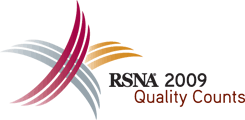
Abstract Archives of the RSNA, 2009
SSK17-06
Shift of Torn Discoid Lateral Meniscus in Children: Incidence and Type on MRI
Scientific Papers
Presented on December 2, 2009
Presented as part of SSK17: Pediatrics (Musculoskeletal)
Jee Young Jung, Abstract Co-Author: Nothing to Disclose
Sang-Hee Choi MD, Abstract Co-Author: Nothing to Disclose
Sung Yoon Park, Presenter: Nothing to Disclose
Jong Won Kwon MD, Abstract Co-Author: Nothing to Disclose
Sung Hoon Lee MD, Abstract Co-Author: Nothing to Disclose
To evaluate the incidence and the type of meniscus shift in surgically proved torn discoid lateral meniscus in children using MR imaging.
Between December 1997 and December 2008, 74 knees of 63 patients (mean age 11.2years, range 3-18years) that underwent knee MRI and arthroscopic surgery at our institution for discoid lateral meniscus were enrolled. For knee MR imaging, fat saturation Proton density weighted (PDW) spin echo (SE) images in the axial plane, PDW SE images in the sagittal, PDW SE or T2-weighted SE images in the coronal planes, and T2-weighted SE images in the sagittal plane were obtained on 1.5T or 3T MR unit. Two musculoskeletal radiologists reviewed MR images retrospectively by consensus. The presence of meniscal tear, the presence and the type of meniscus shift in torn discoid lateral meniscus were assessed and classified. The types of torn discoid lateral meniscus shift were as follows: antero-central shift, postero-central shift, and central shift. Operative findings were regarded as the reference standard.
Arthroscopic surgery revealed 67 meniscal tears (18 horizontal tears, 29 peripheral longitudinal tears, 20 complex tears). Among the torn menisci, 46 (69%) meniscus shifts were seen at arthroscopic surgery. Surgically proved shift types were 24 central shifts, 5 anterocentral shifts, and 17 posterocentral shifts. The sensitivity, specificity for the diagnosis of meniscus shift using MR imaging was 89%, 93%, respectively. Two readers found 13 central shifts, 7 anterocentral shifts, 23 posterocentral shift on MR imaging. The sensitivity, specificity for the diagnosis of meniscal tears using MR imaging was 85 %( 57/67), 57 %( 4/7), respectively.
Meniscus shift was found in 69% of torn discoid lateral menisci in children at arthroscopic surgery. MR imaging is useful in the detection and classification of meniscus shift in torn discoid lateral meniscus.
Meniscus shift which could be a cause for locking symptom or blocking extension was frequently found in torn discoid lateral meniscus in children on MR imaging.
Jung, J,
Choi, S,
Park, S,
Kwon, J,
Lee, S,
Shift of Torn Discoid Lateral Meniscus in Children: Incidence and Type on MRI. Radiological Society of North America 2009 Scientific Assembly and Annual Meeting, November 29 - December 4, 2009 ,Chicago IL.
http://archive.rsna.org/2009/8015213.html

